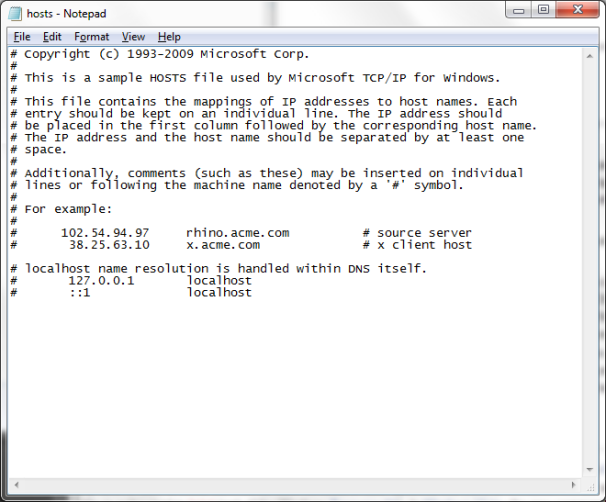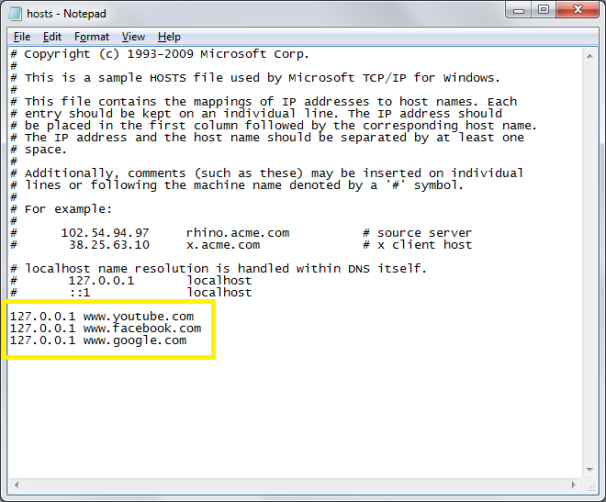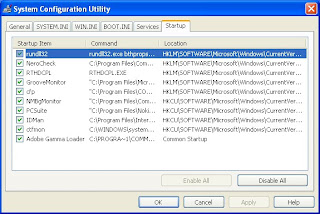Block a Website on Your PC
1. Open Windows Explorer and navigate to C:\Windows\System32\drivers\etc. If Windows is not installed on C:, substitute the appropriate drive letter.
2. Double-click hosts, and select Notepad when Windows prompts you to choose a program. If you don't get the prompt, or if the hosts file opens in another program, open Notepad (Start, All Programs, Accessories, Notepad), and then navigate to hosts by clicking File, Open within Notepad.

3. Place the cursor at the end of the last line, which will say something such as '127.0.0.1 localhost' or '::1 localhost'. Press Enter to create a new line.
4. Type 127.0.0.1, tap the spacebar once, and then type the address of a website you want to block. For example, to block all traffic from YouTube, type127.0.0.1 www.youtube.com on this line.
5. Continue to add the websites you wish to block, each prefaced with 127.0.0.1 and a space.

6. Click File, Save to commit to your changes. Dismiss any warnings from antimalware software, which may be triggered by your editing of the hosts file.
7. Close any open browser windows, and then reopen a browser to test your edits. The blocked sites should not display in any browser.
Selectively Block a Website Based on User or Time of Day
If blocking a site from all users at all times is overkill for your situation and you want more control, try using your router’s Web interface to block a website selectively.
1. Open a browser and enter your router’s IP address into the address bar. Refer to your router’s documentation for the IP address, or, if you don’t immediately know it, try a common address such as http://192.168.1.1, http://192.168.0.1, or http://192.168.2.1.
2. Enter your username and password. If you haven’t changed the username and password, and you don’t know the defaults, visit Port Forward’s Default Router Passwords page to find them.
3. Browse to the section where you can block websites, computers, and access during certain times of day. Router interfaces vary, but look for a section with a name such as 'Access Restrictions'.
4. Enter the details of the content and the users you’d like to restrict, and save your changes. Your router’s paper or electronic documentation should provide full instructions.
Remember to exercise caution when editing your hosts text file, and always make sure to back up files before you edit them.
Blocking a website on a router
 Most home networks today have a network routerfor sharing an Internet connection between multiple devices. In addition to routing the network information between devices, the router can also block websites. We recommend blocking a website through a router because it can be password protected to prevent the block from being bypassed and because it will block a website on all devices. This means if you were trying to block Facebook from your children it will be blocked on the computer as well as any cell phone or tablet connected to your home network.
Most home networks today have a network routerfor sharing an Internet connection between multiple devices. In addition to routing the network information between devices, the router can also block websites. We recommend blocking a website through a router because it can be password protected to prevent the block from being bypassed and because it will block a website on all devices. This means if you were trying to block Facebook from your children it will be blocked on the computer as well as any cell phone or tablet connected to your home network.
To block a website on a router connect to the home network router, typically this is done by opening a browser and visiting the default router address: http://192.168.1.1
If this address does not work or you're having trouble accessing your router setup visit the link below.
After connecting to the router, block a website through one of the below features. Unfortunately, every router setup is different so you'll need to find one of the below settings for your manufacturer of the router. Generally one of these options will be available under a "Security", "Parental control", "Firewall" tab or button.
- URL Filter - Some routers may have a URL filter section, which allows you to enter the URL for each website you want to block.
- Parental controls - New and more advanced routers have a section dedicated to parental controls, which gives you not only the option to block websites but also specify the times the Internet can be accessed.
- Firewall - Finally, if neither of the above options is available the router should offer some type of filtering through the Firewall router settings.
Block a website using Family safety
Note: Blocking a site using these steps only blocks the website on one computer. Any other computer, phone, or tablet connected to your computer will be able to access the site you're blocking.
The new versions of Windows include a new Windows Family Safety feature that allows parents to setup computer usage rules and includes the ability to only allow certain websites or block websites. If you're running Windows 7 or Windows 8, open Family Safety from either the Windows Start Menu or Start Screen by typing "family" and then clicking on the Family Safety shortcut that should appear.
When open you'll have a screen that resembles the example below which gives you access to web filtering, time limits, logs, as well as the type of games that can be played.

Blocking a website in Windows
Note: Blocking a site using these steps only blocks the website on one computer. Any other computer, phone, or tablet connected to your computer will be able to access the site you're blocking.
A website can be blocked on any Windows computer by editing the hosts file, in Windows this file is referred to as the lmhost file.
Locate the hosts file in Windows Explorer. For Windows XP and up, it will be located in the directory C:\WINDOWS\system32\drivers\etc\. In Windows 2000/NT, C:\WINNT\system32\drivers\etc\. In Windows 98 and ME, C:\WINDOWS\.
Navigate to the proper directory using Windows Explorer. Double-click the hosts file. Choose Notepad from the list of programs to open the file and edit it in Notepad.
Find the line below:
127.0.0.1 localhost
Right underneath it, add the following lines (replacing badsite.com with the site you want to block):
127.0.0.1 badsite.com
127.0.0.1 www.badsite.com
127.0.0.1 www.badsite.com
Click on the File menu and click Save. Close the file. The site should be blocked in all web browsers and now instead of trying to access that site the computer will redirect you to the localhost.
Blocking a website using software
Note: Blocking a site using these steps only blocks the website on one computer. Any other computer, phone, or tablet connected to your computer will be able to access the site you're blocking.
You can also block websites using a software firewall or a filter (such as a parent control Internet filter). Also, most anti-virus software will come with a firewall or have an option to obtain one from them. Filtering software may also be available through the same companies or could be obtained separately. To configure these pieces of software to block websites, you need to follow the instructions provided by the software vendor.
Blocking a website in a browser
Note: Blocking a site in a browser only blocks the site in one browser. Any other browser, computer, phone, or tablet connected to your computer will be able to access the site you're blocking.
Although not available with the default install of Firefox, there are plenty of add-ons that allow you to block sites in Firefox. Below are the steps on how to install BlockSite, a great add-on to block websites.
- Click on the Tools menu and click Add-ons. If you don't see Tools press the Alt key.
- In the top-right corner of the Add-ons Manager page, there is a search bar. Perform a search for BlockSite. The first result should be the add-on called BlockSite. Click the Install button to install the add-on.
- Restart Firefox to complete the installation.
- Click on the Tools menu and click Add-ons. This takes you to the Add-ons Manager page. Click the Extensions tab.
- In the listing for BlockSite, click the Options button. The screen below will be shown.

In the BlockSite Preferences click the Add button. In the window asking for the Web address to block enter the address of the website to block and click the OK button. Click the OK button to exit BlockSite and continue browsing
Note: If you're running Windows 7 or Windows 8, Windows now handles all the below settings through Family Safety.
- Click Tools in the File menu and click Internet Options. If Tools is not visible press the Alt key.
- In the Internet Options window click on the Content tab.
- Under the Content Advisor heading, click Enable if it has not yet been enabled, or click Settings, enter your supervisor password and click the OK button.
- In the Content Advisor window click the Approved Sites tab to show a screen similar to the example below.

Enter the Web address to block and click the Never button. Click the OK button to exit the Content Advisor window, then click OK again to exit the Internet Options window and continue browsing. Blocking in Google Chrome and other browsers
Chrome does not come included with any type of website blocking tool or feature. However, there are plenty of Chrome Extensions that can be added that allow you to block a website. Visit the Chrome web store and search for "blocksite" to pull up a listing of available extensions that will block websites.










